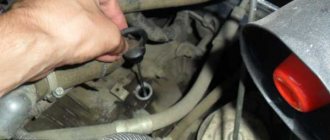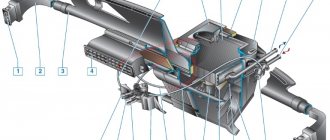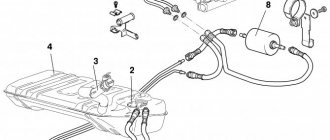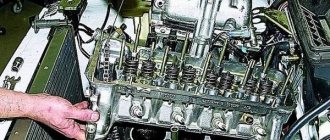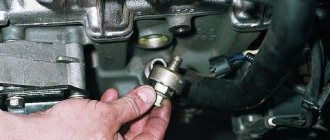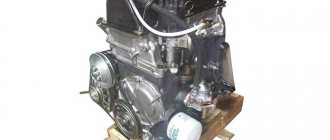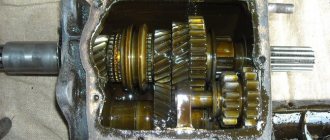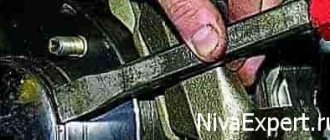- home
- Brands
- VAZ
29.09.2020
VAZ Niva (Lada 4x4) is a compact off-road vehicle, produced with a three- and five-door body. Production of the model began in 1977. In the 2010s, under the leadership of AvtoVAZ President Bo Andersson, an updated version of the Urban was developed with modified bumpers and improved finishing. In 2020, the car received a new front panel, adapted to modern safety and comfort requirements. However, the design remains the same. The original name “Niva” was relevant until 2006 in connection with the release of the more modern Chevrolet Niva SUV. However, in 2021, AvtoVAZ regained the right to use the Niva trademark, which previously belonged to the General Motors concern.
How much oil to fill in Niva
First generation 2121, since 1977
Despite the lightweight monocoque body and structural basis from the VAZ-2106, the Niva has impressive off-road capabilities largely due to its short wheelbase and almost non-existent body overhangs, which ensures high approach and departure angles. The car also has permanent all-wheel drive and is equipped with a transfer gearbox. Under the hood there is a non-alternative 1.7 petrol engine with a power of 81 hp. s., aggregated with a five-speed manual transmission. In 2021, AvtoVAZ improved the car's suspension - installed gas-filled shock absorbers and bearings in the front hubs, and also introduced independent mounting of the front axle gearbox. Since 2021, the car has been officially sold as Lada Niva.
- Transfer case oil: volume – 0.79 liters, tolerance and viscosity: API-GL-3-4; SAE 75W-90
- Rear axle gearbox oil: volume 1.3 liters; front - 1.15 liters; tolerance and viscosity: API-GL-3-4; SAE 75W-90
Also read: Oil for manual transmission VAZ-2112
Types of transmission oils suitable for VAZ 21214
Eneos 80W90 Gear GL5
Viscosity is constantly maintained. Can be used at minus 30.
Castrol Syntrax Universal Plus 75W90 GL4/GL5
The main advantage is the extended replacement period, reaching 300,000 kilometers. The speeds switch on smoothly, the box operates almost silently. The only drawback is the high cost.
Mobil Mobilube HD 75W90 GL5
It is very popular. There are practically no negative reviews about quality. It differs from many analogues in its low price.
Gazpromneft GL5 80W90
Produced in Russia. Disadvantages include difficult gear shifting. Can be used in car axles.
Shell Spirax S5 ATE 75W90 GL4/GL5
Designed for use in racing cars. Excellent for VAZ 21214. Reduces the noise of the transfer mechanism. The manufacturer recommends using the lubricant for driving on bad roads.
Mobil Mobilube GX 80W90 GL4
High quality liquid made on the basis of paraffin materials. The composition includes special additives that reduce wear of parts. Car enthusiasts characterize the lubricant only on the positive side.
What oil to use for VAZ Niva
Original
Three types of transmission oil are poured into the crankcase of the front and rear axles, as well as the transfer case of the VAZ Niva car - mineral, semi-synthetic or synthetic. For cars of recent years of production, semi-synthetic or synthetic is recommended. As for viscosity, SAE 70W, 80W or 85W is suitable for winter use, and SAE 90, 140 or 250 is used mainly in summer. Moreover, the most popular in the Russian environment is an all-season transmission with SAE 75W-80, 80W-85, 80W- 90 or 75W-90.
Unoriginal
To service the transfer case, gearbox and axles of a VAZ Niva, it is better to choose oil from trusted manufacturers - Mannol, Total, Eneos, ZIC, Castrol, Kixx, etc. Regarding the type of viscosity, it should be noted that synthetic oil is more fluid, suitable for cars of recent years release. Accordingly, mineral water or semi-synthetics are recommended for older cars. It has a relatively thick consistency, which means there is less chance of leaks in the presence of microcracks or gaps between contact pairs. Even when choosing an oil, pay attention to the current tolerance indicators API-GL-3, 4 or 5. The higher the indicator, the more oil additives. In the case of Niva, you can opt for API-GL-5. Below are suitable oils for the transfer case, axles and gearbox of the VAZ Niva.
- Liqui Moli 75W-90 GL-4/5
- Chevron 80W-90 GL-5.
Which oil is most suitable for the VAZ 21214 transmission?
It is very difficult to answer this question unambiguously. Some car enthusiasts believe that one type of lubricant should be poured into the axles, and another into the gearbox. Most people fill all transmission components with the same fluid.
The type chosen depends on the operating conditions. For example, a car that constantly crosses small bodies of water will perform better on thick oil. This is due to the fact that water will constantly enter the composition and dilute it. For winter, you can use semi-synthetic motor oils, for example TNK 75W90.
Also, before changing the lubricant, it is necessary to take into account the operating season of the machine. All-season brands that can be used all year round are very common in Russia. Experts advise considering a few simple rules before purchasing:
- Familiarize yourself with the composition and read the manufacturer's recommendations.
- There is no need to strive to purchase a very expensive liquid if it is not recommended by the manufacturer. Its properties may not be suitable, and the lubrication system may fail.
- The lubricant must be changed within the specified time frame. If this is not done, the box parts will quickly wear out.
- If the vehicle's mileage is high enough, replacement should be performed more frequently.
- You should always monitor the oil gauge. It must always be in good condition.
The oil level must always be stable. If necessary, you need to top up the transmission fluid.
What is the best gear oil to fill?
Lubricants consist of a base (base) and additives. Their chemical and physical properties depend on the composition and origin of these components.
According to the method of manufacturing the base, the transmission is divided into three types:
- Mineral is a product remaining after the distillation of oil in the production of diesel fuel and gasoline. Includes heavy fractions of hydrocarbons and contains large amounts of sulfur. Its properties are determined by naphthenes, aromatics and paraffins. The oil entering oil refineries differs in its composition. This does not allow achieving stable mixture proportions. Therefore, the final parameters are adjusted with additives. Under the influence of temperature, heavy fractions of hydrocarbons disintegrate, and additives oxidize and lose their properties. This oil has to be changed more often. Another disadvantage of “mineral water” is that oxidation products settle on parts.
- The synthetic base is artificially created from the desired hydrocarbons. Thanks to this, it is possible to obtain a product with predictable viscosity values without the use of additives. Additives are used only to improve the lubricating and antioxidant properties of the transmission.
- Semi-synthetic oils are created on the basis of a mixture of mineral and synthetic bases (at least 30% of the latter is used). This approach allows you to reduce the number of additives that change viscosity.
Synthetic gear oil differs from mineral and semi-synthetic oil in that its viscosity changes less with temperature changes. This reduces wear on transmission parts during winter operation of the Chevrolet Niva. But “synthetics”, due to their greater fluidity, seep through worn gearbox seals more easily.
However, the main characteristic of a lubricant is viscosity. This is what is indicated in the operating instructions. The manufacturing company recommends filling in the following types of gear oils (according to SAE):
- Transfer case and gearbox - 75W-90, 80W-85, 80W-90.
- Drive axles (front and rear) - 80W-90, 85W90.
Important: it is not allowed to fill the gearbox with a transmission of the popular API GL-5 quality standard. The sulfur-phosphorus and extreme pressure additives that are included in its composition disrupt the operation of synchronizers.
Therefore, API GL4 and GL4/GL5 must be poured into the gearbox (gearbox), and GL4/GL5 and GL5 into the axles and transfer case.
There are dozens of gear oil brands on the market. The most famous imported ones are Castrol, Liqui Moly, Mobile, Shell, and the most famous domestic ones are Lukoil and Rosneft.
Prices for a liter bottle start from 400 rubles.
The Lukoil company is the official partner of AvtoVAZ. It is this brand of semi-synthetics that is poured into the transmission during the production of the Chevy Niva.
Selection of oil for transfer case
In order to choose the right lubricant for the transfer case, several factors should be taken into account. One of the most important is compatibility with other liquids used. Before purchasing, be sure to check the viscosity of the lubricant. At the same time, it is not at all necessary to purchase products from one manufacturer. It is also not recommended to use lubricants with different chemical compositions so that they do not mix. This is very important if you want to truly improve the performance of your car. Therefore, if you fill a Chevrolet Niva with semi-synthetics, then in the case of the transfer case, purchase a semi-synthetic lubricant.
Characteristics of motor 21214
It is believed that the basis of the ICE 21214 was the previous version 21213. In fact, ¾ of the parts in the engine
- the engine layout has changed - an injector instead of a carburetor;
- additional attachments appeared - DPKV, DXX sensor, Bosch MP 7.0 controller;
- crankshaft with a long crank radius of 40 mm, not used in previous AvtoVAZ engines;
- Cylinder head with holes for phase sensor and receiver studs, hydraulic supports for valve levers instead of adjusting bolts.
| Manufacturer | AvtoVAZ |
| Engine brand | 21214 |
| Years of production | 1994 – … |
| Volume | 1690 cm 3 (1.7 l) |
| Power | 59.5 kW (81 hp) |
| Torque moment | 127.5 Nm (at 4000 rpm) |
| Weight | 122 kg |
| Compression ratio | 9,3 |
| Nutrition | injector |
| Motor type | in-line |
| Injection | distributed electronically controlled |
| Ignition | modular |
| Number of cylinders | 4 |
| Location of the first cylinder | TVE |
| Number of valves on each cylinder | 2 |
| Cylinder head material | aluminum alloy |
| Intake manifold | duralumin |
| An exhaust manifold | cast iron or welded steel |
| Camshaft | original cam profile |
| Cylinder block material | cast iron |
| Cylinder diameter | 82 mm |
| Pistons | from 21213 |
| Crankshaft | from 21213 |
| Piston stroke | 80 mm |
| Fuel | AI-92 |
| Environmental standards | Euro-2/3 |
| Fuel consumption | highway – 8.3 l/100 km combined cycle 10.5 l/100 km city – 11.5 l/100 km |
| Oil consumption | maximum 0.7 l/1000 km |
| What kind of oil to pour into the engine by viscosity | 5W30, 5W40, 10W40, 15W40 |
| Which engine oil is best by manufacturer | Liqui Moly, LukOil, Rosneft, Mannol, Mobil |
| Oil for 21214 according to composition | synthetics, semi-synthetics, mineral |
| Engine oil volume | 3.75 l |
| Operating temperature | 95° |
| ICE resource | declared 80,000 km actual 160,000 km |
| Adjustment of valves | hydraulic compensators |
| Cooling system | forced, antifreeze |
| Coolant volume | 7.8 l |
| water pump | with plastic impeller |
| Candles for 21214 | BCPR6ES from NGK or domestic AU17DVRM |
| Spark plug gap | 1.1 mm |
| Timing drive | single row chain |
| Cylinder operating order | 1-3-4-2 |
| Air filter | Nitto, Knecht, Fram, WIX, Hengst |
| Oil filter | with check valve |
| Flywheel | from 21213 with clutch bore diameter 200 mm or 215 mm |
| Flywheel mounting bolts | M12x1.25 mm, length 26 mm |
| Valve stem seals | manufacturer Goetze, light inlets, dark exhausts |
| Compression | from 12 bar, difference in adjacent cylinders maximum 1 bar |
| XX speed | 800 – 850 min -1 |
| Tightening force of threaded connections | spark plug – 31 – 39 Nm flywheel – 62 – 87 Nm clutch bolt – 19 – 30 Nm bearing cap – 68 – 84 Nm (main) and 43 – 53 (rod) cylinder head – three stages 20 Nm, 69 – 85 Nm 90° 90° |
Engine VAZ 21214 1.7l
Changing engine oil is an essential component of proper operation of any car.
Timely replacement of the working fluid and oil filter allows you to maintain the engine in optimal condition, ensuring its long-term and trouble-free operation. Therefore, the owners of this domestically produced SUV have a logical question about what kind of oil to pour into the Niva 21214 with an injector, how much is required, and how to carry out the replacement procedure yourself. Selecting oil for Niva 21214 is not so difficult. But here you need to know some nuances in order to avoid common mistakes. Let's start with the time of year. Not every car owner knows what kind of oil to pour into the engine of his Niva if it’s summer or winter outside. In summer the weather is hot, so passenger car engines get very hot under such conditions.
“Niva 21214” is an all-wheel drive SUV, and its engine warms up even more. That’s why many people make the same mistake, filling in mineral or semi-synthetic oil for the summer. To ensure that the engine runs efficiently and does not overheat, experts recommend using high-quality synthetics.
If the lubricating fluid in the power unit has an insignificant percentage of viscosity, you should not expect the expected effect from it. When the cylinder block heats up, such oils have a consistency similar to ordinary water and their temperature rises rapidly. Therefore, the lubricant will no longer take heat from the engine, performing a cooling function, and will also not be able to create the required pressure. Operating in this mode will lead to rapid jamming of the crankshaft.
Therefore, the manufacturer and experienced car owners themselves advise filling the Niva engine, as well as the Chevy Niva (Chevrolet) engines, with motor oils with a viscosity of 20W40, but not higher than 25W50. These are the optimal viscosity parameters at which the crankshaft can function normally and not create unnecessary load.
- very liquid (otherwise an ice film will form from the cold);
- too thick (otherwise the crankshaft will not be able to rotate when starting a cold engine).
For winter, it is better to fill the engine with oil that meets the viscosity parameters of at least 0W40 and maximum 0W50. By pouring such liquid into the engine in winter, when the temperature drops to a maximum of -40 degrees, the starter can easily cope with cranking. The viscosity is not very high, and even low temperatures will not prevent the engine from starting.
Avoid semi-synthetic oils. Yes, such mixtures can be expensive and have similar characteristics to synthetics. But even the high price and identical labels on the packaging do not allow semi-synthetics to obtain the same properties that synthetic oils have.
The Niva SUV, in all modifications, is very popular in Russian spaces. This is due to good maintainability, low price and excellent maneuverability. To ensure reliable operation, you should undergo all maintenance on time, in particular, change the engine oil.
The VAZ 21214 engine lubrication system is designed to protect against premature wear of moving parts. It completely copes with its task, you just need to follow all the manufacturer’s recommendations.
The VAZ 21214 engine was conceived as the first injection engine for a domestic SUV. The Niva was not particularly popular in the USSR, but was exported to Asia, the UK, Europe, Latin America and the USA. During production since 1994, there have been several improvements and modifications of the internal combustion engine from Euro-0 to Euro-5 (export).
Results
In most cases, the Niva is used for off-road driving, which puts a lot of stress on the transmission. Therefore, it is optimal to change the oil after a mileage of 15–20 thousand kilometers. Do not save where it is fraught with bad consequences. When performing vehicle maintenance, evaluate the condition of all engine components, and also change filters and spark plugs at least once every two oil changes.
Periodically during operation, according to the technical inspection card, it is necessary to change the oil in the transfer case on a VAZ Niva 2121 and 2131. To carry out repair work, prepare a standard set of tools, after which drive the car onto an inspection hole, overpass or lifts. Also, before replacing, the oil in the transfer case must be warmed up; to do this, you should drive at least 10 km.
Changing the oil in the Niva 21214 gearbox
For any vehicle, the importance of timely replacement of lubricants cannot be overestimated. Oils used in components and assemblies subject to friction at high speeds significantly reduce their overheating and wear, helping to extend their service life. Among such components, one cannot fail to note the transfer case, which is equipped with all-wheel drive vehicles.
What to choose for bridges
In most cases, the oil chosen for axles is the same as for the transfer case. Their full compliance guarantees you high functionality of all components of the transmission during active daily use of the car. Most car enthusiasts agree that you should only buy proven lubricants. These include products from the following brands:
- Castrol;
- Lukoil;
- Liqui Moly;
- Mobil;
- Shell;
- Elf;
- ZIC.
This is a list of the most popular and widely used brands. Their products are used by a huge number of car enthusiasts with different experience levels. When purchasing, be sure to check the compatibility of the viscosity and chemical composition with the oil already used in the gearbox.
What kind of oil to pour into the gearbox
Time-tested and widespread brands of lubricating fluids for the Chevrolet Niva gearbox:
- Gazpromneft. Relatively inexpensive domestic brand, good quality.
- Eneos. Stably maintains fluidity at temperatures down to -30 degrees.
- Lukoil.
- Castrol. Softens transmission operation and reduces noise.
- TNK. Russian manufacturer of mineral oils. Recommended for use with low mileage and low vehicle use.
- Shell. It is used in sports cars and performs well in Niva. Usually helps with noise in transmission units. Recommended for use during active off-road use.
- Mobil. High quality oils, containing modern anti-wear additives. Copes well with heavy loads in the transmission in any speed range.
Read more: Outboard bearing KAMAZ 43253
Of course, there are other brands of lubricant manufacturers, but you should trust the brands presented. The manufacturer recommends changing the lubricant every 45 thousand kilometers. But it all depends on the conditions and activity of exploitation.
Stages of replacing lubricant VAZ 21214
Changing the engine oil is a regulated maintenance procedure, which is prescribed in the operating instructions. There is nothing complicated about it if you clearly and carefully follow the described action plan.
Our most popular engines are injection and carburetor engines, with a volume of 1.7 and 1.6 liters. The replacement process on these engines, as well as other modifications, will be the same.
Replacement instructions
It would be logical to find out how much oil is in the VAZ Niva 21214 engine and how much motor fluid is required to purchase. If we talk about the volume of liquid being filled, then for the Niva engine it is 3.75 liters. The actual volume of oil in the engine is usually less than that indicated in the vehicle's data sheet.
This is due to the fact that when draining the waste, some of the oil still remains in the system. It is almost impossible to clean the engine 100% on your own. You should take plenty of oil, but not much. It is better to take a 5 liter canister of high-quality lubricant. This will allow you to fill the full volume into the crankcase, plus periodically add it as the level changes.
To work, you will need to collect some materials and tools. This list includes:
- fresh motor oil in the right quantity;
- an empty container where the waste will be drained;
- funnel for filling;
- fuel filter;
- 12mm hex or 17mm wrench;
- puller for the oil filter (you can do without it);
- inspection hole;
- rags;
- lighting;
- overalls (gloves, closed shoes, thick clothing).
If you have everything ready, you can start working. Be sure to follow the instructions step by step, do not rush and do not try to unscrew or tighten anything by applying great force. Otherwise, you risk breaking some parts, which will lead to more expensive repairs. We begin the procedure for changing the engine oil, changing the filter at the same time.
- Place the car on an inspection hole to have easy access to the bottom where the oil pan is located. The engine should be warmed up first so that the oil acquires a more liquid structure and can easily drain from the sump.
- If you warmed up the engine at idle, wait a few minutes so that all the liquid drains down. You can still unscrew the filler plug in the engine compartment. This will allow the oil to come out from below faster.
- Carefully unscrew the drain plug. It comes in different types, so you will need a hexagon or wrench to dismantle it. Before you begin to unscrew the cap, place an empty container under it. Unscrew completely and let the oil drain. This will take about 10 – 15 minutes. Therefore, at the same time, work on the oil filter.
- If the oil comes out very dirty, then a lot of debris, chips and dirt will remain in the system. In this condition, it is recommended to flush the engine. To do this, use special additives, flushing mixtures or fresh oil.
- There are additives that you simply add to the filler neck while the old grease is still there, start the engine and let it run for a few minutes. Then they are jammed and everything is removed from the pan.
- The option with flushing oil or regular fresh engine oil looks different. First, the old fluid is drained, then the drain plug is closed, fresh oil is added, the engine is turned on and it runs at idle speed for 5 - 10 minutes. Now the pan plug is unscrewed again and drained. If the engine is heavily dirty, it is recommended to repeat the procedure 2–3 times. This takes a lot of oil, but it gives the engine new life.
- Only after complete washing is the old filter removed and a new one installed in its place. The filter is unscrewed with a puller, manually or with an improvised tool. The puller is the most convenient, but is not always available to the car owner. Be careful not to damage adjacent pipes and wiring. For safety reasons, it is better to remove the negative terminal from the battery.
- Clean the holes for the drain plug and the filter if there is dirt there. Otherwise, they may get into the fresh motor fluid.
- Before reinstallation, check the plug gasket and replace it if necessary. The filter seal is lubricated with oil, and engine fluid is filled to 50% of the volume of the new filter. Now you can install them in place.
- Make sure that the filter and plug are firmly in place and that there are no leaks through them.
- We move on to the engine compartment, where we use a funnel to pour fresh composition through the filler neck. Fill in about 3.5 liters first, since some of the oil remains in the system. Close the lid and run the engine at idle speed for 2 - 3 minutes.
- Turn off the engine and let the oil drain. Take the dipstick and check the level. A trace of the oil film should remain between o and “Max”. If the level is closer to the minimum value, open the lid again, add a little more lubricant and repeat the procedure.
And also interesting: Do-it-yourself Niva suspension lift. How to lift the front and rear suspension of a Niva car?
When you start the car, the oil pressure light will come on. It's not scary, it always happens. The indicator will go out after a few seconds. Over the next few days, monitor how your Niva behaves. Check under the car for traces of fresh oil. Leaks may occur due to a poorly installed filter or drain plug. Tighten the connections and recheck the level.
Owners of the VAZ Niva 21214 car are advised to periodically monitor the oil level, add it as needed and react promptly if the liquid suddenly changes color, becomes cloudy, its consumption increases or the engine overheats. Signs like these indicate more than just a leak.

